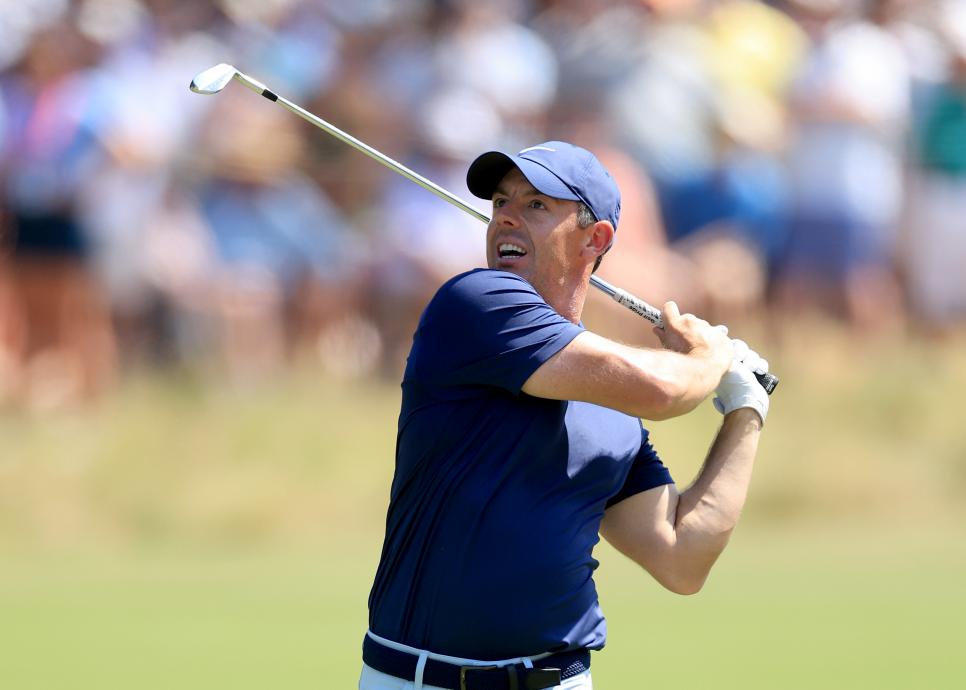U.S. Open 2024: Accepting the chaos is the only thing that matters – Australian Golf Digest

- by Admin
- June 15, 2024

PINEHURST, N.C. — He had done all the right things but the result was still wrong. It takes a lot for Scottie Scheffler to emote, but he had stayed stoic for too long, so when the putt that should have been good wasn’t Scheffler tossed his putter like a baton, too disgusted to attempt to catch it as it crashed back to earth. His hands on his hips and his head tilted toward the sky said as much, but Scheffler made sure to say it anyway.
“The game of golf is a mental torture chamber at times,” Scheffler said after a Saturday 71, “especially the U.S. Open.”
When it’s fully actualized, the U.S. Open is not so much a tournament as it is a test. It is both the championship’s aspiration and aura, and at times its Achilles heel, especially when the challenge is presented in a perceived artificial fashion, yet even in controversial times the player who was left standing earned a respect for passing golf’s most thorough examination. This hasn’t been the case as of late; the competition—like most modern professional competitions—able to be unlocked by power and power alone. At Pinehurst, those quintessential ingredients have returned, the No. 2 course calling for muscle but also accuracy and scrambling, and if your putter isn’t on neither is your name on the leaderboard. This finesse must be coupled with creativity, conviction, audacity, calculation, and patience. It sounds exhausting under any circumstances and especially so in temperatures where even the beer cans are sweating and that’s the point, leaving the field walking off in need of a cold shower and stiff drink.
But these physical and mental abilities are focused on the shot ahead, and while they are prerequisites to success they are ultimately subservient to another trait. It’s what happens after a shot, and how a player responds, that has made all the difference at Pinehurst.
“For me, I knew every hole out here is so tough that if I let it affect me, then you might as well just call it over and just kind of walk it on in,” Collin Morikawa said after a Saturday 66.
On the surface, U.S. Open golf is sequential. In order to make a good score you don’t just have to find the fairway but the proper angle to allow for the best approach, and anything less is punished. Through three days that’s been true of Pinehurst, the nuances of No. 2’s turtleback contours prohibiting the field from deviating from game plan. Conversely, part of the beauty of Pinehurst is its volatility. Unlike traditional U.S. Open rough at a Winged Foot, Pebble Beach or Oakland Hills (where missing the fairway means hoping to advance the ball far enough to have a chance at par), Pinehurst’s native areas are a fusion of sand, soil and pineweed. That can produce a clean lie, but also anything from a flier to punch-out to chunk. Just ask Scheffler, who saw his U.S. Open come undone by a double-bogey 7 at the easiest hole on the course Friday after finding a sandscape to the left of the green. Missing the fairway should be penal, but that the native areas also allow for escapes instills the belief that providence is involved to a fair degree.
The belief is only amplified when it comes to second shots. Those turtleback greens are not particularly receptive, leading some to joke the stat shouldn’t be “greens in regulation” but “greens visited,” a nod to a ball that should have been on the green finishing in a spot off the putting surface. A number of approaches have gone viral this week for looking perfect, only for the ball to keep moving … and moving … and moving, the camera cutting back to the player wondering what the hell he’s exactly supposed to do. On Friday the par-3 ninth featured two holes-in-one but also a number of shots ricocheting off the slowly-browning green and finishing 30 yards from the flag. On Saturday a shocking amount of players couldn’t get the ball to the green and those that did failed to hold it. The broadcast wondered if Round 2’s pin placement on the 15th was rewarding good shots. Even the short game is an adventure, a handful of guys putting off the green from inside 20 feet this week.
David Cannon
It’s fun to watch for amateurs, the world’s best made to look like us, although the field can be left wondering, rightfully or not, if they are playing a game of skill or chance.
“I would say embracing the difficult conditions, embracing the style of golf needed to contend at a U.S. Open, embracing patience,” Rory McIlroy said earlier in the week. “Honestly, embracing what I would have called “boring” back in the day. Explosiveness isn’t going to win a U.S. Open. It’s more methodically building your score over the course of four days and being okay with that. Honestly, it’s just more of a reframing of a mindset than anything else.”
In short, Pinehurst is not kinetic. It tosses out its own script and makes the performers improvise on the spot. It’s a chaos seen just once a year.
That assertion is not revelatory and far from new. The majority of PGA Tour set-ups are pampered to the membership’s wants. There’s little variability from venues week-to-week, almost each course arranged in a way that’s conducive to scoring. Golf is not a game of perfect; of course there are still wayward shots and missed putts, yet foreign, unexpected bounces are not the norm. So when things don’t go their way, especially when they think things should, they tend to convince themselves that what they are doing is not proper golf. No need to tell the USGA this; Zach Johnson’s “They’ve lost the golf course” criticism from 2018 remains fresh. Publicly, players have shied away from criticizing this week, deeming the course hard but fair. Privately, there’s a lot of shoulder shrugs and, “Hey, it’s not on me” looks. In a sense this is understandable. The line between heaven and hell is so thin at this level that to predicate your sanity on results alone is a path to madness. Defecting blame is not eschewing responsibility. It’s a means of survival.
Unfortunately, divorcing one’s self from accountability can have unintended consequences. When things don’t go players’ way, especially when they think things should, they tend to convince themselves that what they are doing is not proper golf and mentally take themselves out of the competition. The secret lies in knowing the course is going to throw a haymaker you don’t see coming, and might be below the belt, and that you’re going to have to pick yourself up for the fight to continue. It’s accepting what happened and moving on.
Few players embodied this sentiment like Payne Stewart did at Pinehurst in 1999. Because of its tragic ending, Stewart’s life tends to be framed through a rosy prism of revisionist history. For most of his career Stewart was a tortured artist, his talent never in doubt but often compromised by immaturity and anger. The smallest of perceived slights on the course—a bad bounce, misreading a line, his ball finding a divot—would send Stewart spiraling, keeping him from reaching his true potential. Yet Stewart underwent a dramatic transformation in his 40s, an evolution he credited to finding religion, and the upshot was a man who was now at peace within himself no matter the breaks or score. It was that long-sought equanimity, being able to keep calm in the storm, that helped Stewart win his third major title here 25 years ago.
Stewart’s long-time caddie Mike Hicks is on the grounds this week, and spoke about what Stewart had, and how few players of today have it.
“There’s 70 percent of the guys this week got no shot because they’re going to be toast with the first sign of adversity. Punch them and they’re going to be down,” Hicks said. “The game is so exact. Players know so much about their own games, their own swings, and kind of how the ball behaves. This week is so different.
“There’s less acceptance now than there was 20 years ago,” Hicks continued. “This generation, there’s not any accountability at all. That’s one of the reasons I got out of [caddieing], because of the lack of accountability.”

Bob Martin
Before labeling Hicks as the old man yelling at the sky, he pointed to Scheffler as one who possesses Stewart’s resilience. It hasn’t been Scheffler’s week, making the cut but miles out of contention. This week’s been an aberration, however, as Scheffler is well on his way to a third straight Player of the Year award. Earlier in the week Scheffler—who also had the reputation of running hot once upon a time—talked about importance of acceptance, good and bad.
“I think I learned over the course of my career to stay as patient as possible,” Scheffler said. “Think that’s something you learn playing more and more golf, is that bad breaks are going to come but it’s more about your response to those things than really receiving the bad break because over the course of a 72-hole tournament you’re going to get plenty of bad breaks and hit plenty of bad shots. It’s more about how am I going to recover from those shots.”
It’s why “good bogey” isn’t said in jest at the U.S. Open, why playing defense is arguably the best offense and why it’s not imperative to make a run but rather to not take yourself out of the running. Make no mistake, Pinehurst is presenting an exam that will test every facet of a player’s game. But the only way to properly respond to its questions, to be the last man standing on Sunday, is accepting the right answers will occasionally be wrong.
MORE GOLF DIGEST U.S. OPEN COVERAGE
U.S. Open 101: Answering all your frequently asked questions
How to watch the 2024 U.S. Open
Power Rankings: Every player in the U.S. Open field, ranked
The 13 best bets to win at Pinehurst
‘A New Day’: USGA president Fred Perpall brings dynamic personality and drive to golf
Video: Every hole at Pinehurst No. 2
Is the USGA going to set up Pinehurst extra hard because of recent low scores in majors?
Tiger is playing Pinehurst on a special exemption. Here’s what it is and why he got it
What would you shoot at the U.S. Open? Our new tool will tell you
U.S. Open anchor sites are about far more than golf
The U.S. Open champion who died in a jail cell
The USGA is about to play its 1,000th championship. The best 9 stats from the first 999
This article was originally published on golfdigest.com
The Latest News
-
December 27, 2024Don’t like pills? Here’s an alternative pain-management treatment to consider for your golf aches and pains – Australian Golf Digest
-
December 27, 2024Charley Hull shares grueling Christmas workout, puts all of us to shame – Australian Golf Digest
-
December 27, 2024Ryan Ruffels’ pro career hasn’t matched high expectations. He’s hoping YouTube can help boost a comeback – Australian Golf Digest
-
December 27, 2024‘Not about Virat Kohli or India’ – Former Australia coach Justin Langer slams media’s witch-hunt after being a past victim himself | Sporting News India
-
December 27, 2024Australian Heta lands nine-darter at World Champs





